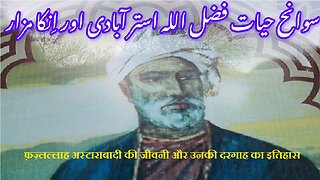Premium Only Content

End of the Bahri regime of Mamluks || مملوکوں کی بہاری حکومت کا خاتمہ
@islamichistory813 #BahriRegime #MamlukDynasty #MiddleEasternHistory #End #Bahri #regime #Mamluks
End of the Bahri regime of Mamluks
Dekhti Aankhooon aur sountay kaanoon ko Asslamoalaikum, sisters, brothers friends and elders, In this islamic informative video, we are describing the conclusion of the Bahri regime of the Mamluks, a pivotal moment in Egyptian history. Through a detailed narrative, we highlight the causes and consequences of the regime's downfall, including the internal strife and external pressures that led to its demise. watch complete video and get to know that how this period shaped the future of Egypt and the broader Middle Eastern landscape.
Al-Nasir Muhammad died in 1341 and his rule was followed by a succession of descendants in a period marked by political instability. Most of his successors, except for al-Nasir Hasan and al-Ashraf Sha'ban, were sultans in name only, with the patrons of the leading mamluk factions holding actual power. The first of al-Nasir Muhammad's sons to accede was al-Mansur Abu Bakr, who al-Nasir Muhammad designated as successor. Al-Nasir Muhammad's senior aide, Qawsun, held real power and imprisoned and executed Abu Bakr and had al-Nasir Muhammad's infant son, al-Ashraf Kujuk, appointed instead. By January 1342, Qawsun and Kujuk were toppled, and the latter's half-brother, al-Nasir Ahmad of al-Karak, was declared sultan.[86] Ahmad relocated to al-Karak and left a deputy to govern in Cairo. This unorthodox arrangement, together with his seclusive and frivolous behavior and his execution of loyal partisans, ended with Ahmad's deposition and replacement by his half-brother al-Salih Isma'il in June 1342. Isma'il ruled until his death in August 1345, and was succeeded by his brother al-Kamil Sha'ban. The latter was killed in a mamluk revolt and was succeeded by his brother al-Muzaffar Hajji, who was also killed in a mamluk revolt in late 1347.
After Hajji's death, the senior emirs hastily appointed another son of al-Nasir Muhammad, the twelve-year-old al-Nasir Hasan. Coinciding with Hasan's first reign, in 1347–1348, the Bubonic Plague arrived in Egypt and other plagues followed, causing mass death in the country, which led to major social and economic changes in the region. In 1351, the senior emirs, led by Emir Taz, ousted and replaced Hasan with his brother, al-Salih Salih. The emirs Shaykhu and Sirghitmish deposed Salih and restored Hasan in 1355, after which Hasan gradually purged Taz, Shaykhu and Sirghitmish and their mamluks from his administration. Hasan recruited and promoted the awlad al-nas (descendants of mamluks who did not undergo the enslavement/manumission process) in the military and administration, a process lasted for the remainder of the Bahri period. This caused resentment among Hasan's own mamluks, led by Emir Yalbugha al-Umari, who killed Hasan in 1361.
Yalbugha became regent to Hasan's successor, the young son of the late sultan Hajji, al-Mansur Muhammad. By then, mamluk solidarity and loyalty to the emirs had dissipated. To restore discipline and unity within the Mamluk state and military, Yalbugha revived the rigorous training of mamluks used under Baybars and Qalawun. In 1365, a Mamluk attempt to annex Armenia, which had since replaced Crusader Acre as the Christian commercial foothold of Asia, was stifled by an invasion of Alexandria by Peter I of Cyprus. The Mamluks concurrently experienced a deterioration of their lucrative position in international trade and the economy declined, further weakening the Bahri regime. Meanwhile, the harshness of Yalbugha's educational methods and his refusal to rescind his disciplinary reforms provoked a mamluk backlash. Yalbugha was killed by his mamluks in an uprising in 1366. The rebels were supported by Sultan al-Ashraf Sha'ban, who Yalbugha had installed in 1363. Sha'ban ruled as the real power in the sultanate until 1377, when he was killed by mamluk dissidents on his way to Mecca perform the Hajj.
Sha'ban was succeeded by his seven-year-old son al-Mansur Ali, though the oligarchy of the senior emirs held the reins of power. Among the senior emirs who rose to prominence under Ali were Barquq and Baraka, both Circassian mamluks of Yalbugha. Barquq was made atabeg al-asakir in 1378, giving him command of the Mamluk army, which he used to oust Baraka in 1380. Ali died in May 1381 and was succeeded by his nine-year-old brother, al-Salih Hajji, with real power held by Barquq as regent. The next year, Barquq toppled al-Salih Hajji and assumed the throne.
His accession was enabled by Yalbugha's mamluks, whose corresponding rise to power left Barquq vulnerable. His rule was challenged by a revolt in Syria in 1389 by the Mamluk governors of Malatya and Aleppo, Mintash and Yalbugha al-Nasiri, the latter a mamluk of Yalbugha. The rebels took over Syria and headed for Egypt, prompting Barquq to abdicate in favor of al-Salih Hajji. The alliance between Yalbugha al-Nasiri and Mintash soon fell apart and factional fighting ensued in Cairo, with Mintash ousting Yalbugha. Barquq was arrested and exiled to al-Karak where he rallied support. In Cairo, Barquq's loyalists took the citadel and arrested al-Salih Hajji. This paved the way for Barquq's usurpation of the sultanate once more in February 1390, firmly establishing the Burji regime. The ruling Mamluks of this period were mostly Circassians drawn from the Christian population of the northern Caucasus.
Barquq solidified power in 1393, when his forces killed the major opponent to his rule, Mintash, in Syria. Barquq oversaw the mass recruitment of Circassians (estimated at 5,000 recruits into the mamluk ranks and the restoration of the state's authority throughout its realm in the tradition of Baybars and Qalawun. A major innovation to this system was the division of Egypt into three niyabat (sing. niyaba; provinces), similar to the administrative divisions in Syria. The new Egyptian niyabat were Alexandria, Damanhur and Asyut. Barquq instituted this to better control the Egyptian countryside from the rising strength of the Bedouin tribes. He further dispatched the Berber Hawwara tribesmen of the Nile Delta to Upper Egypt to check the Arab Bedouins.
During Barquq's reign, in 1387, the Mamluks had forced the Anatolian entity in Sivas to become a Mamluk vassal. Towards the end of the 14th century, challengers to the Mamluks emerged in Anatolia, including the Ottoman dynasty and the Turkmen allies of Timur, the Aq Qoyunlu and Qara Qoyunlu tribes of southern and eastern Anatolia.
Tomorow we will be described Crises and restoration of state power by Shaykh. So permission us upto tomorow. Allah Hafiz
==============================
-
 6:57
6:57
ISLAMIC HISTORY
1 day agoFazlallah Astarabadi | फ़ज़लल्लाह अस्तराबादी | فضل اللہ استرآبادی کی سوانح عمری اور مزار کی تاریخ
3 -
 LIVE
LIVE
SynthTrax & DJ Cheezus Livestreams
1 day agoFriday Night Synthwave 80s 90s Electronica and more DJ MIX Livestream Trip-Hop SPECIAL EDITION
655 watching -
 LIVE
LIVE
I_Came_With_Fire_Podcast
9 hours agoTARIFF TAKEOVER | REDCOATS 2.0 | DOGE FINDS SOMETHING HORRIBLE
225 watching -
 4:03:27
4:03:27
FusedAegisTV
8 hours agoRumble Smackdown! #001 Street Fighter 6 $500 Online Tournament
25.1K3 -
 55:58
55:58
BonginoReport
5 hours agoCan Trump Make TikTok Great Again? (Ep. 20) - Nightly Scroll with Hayley Caronia - 04/04/25
102K61 -
 LIVE
LIVE
Jorba4
1 hour ago🔴Live-Jorba4- COD WARZONE- VERDANSK FRIDAY. Hot drops W/ XxXAztecWarrior and Lumpy Potato X2
116 watching -
 4:33:11
4:33:11
Nerdrotic
7 hours ago $27.13 earnedPost-Apocalyptic Woke Hollywood, MineCRAP, CinemaCONNED - Friday Night Tights 348, Chris Gore & Rags
106K14 -
 1:00:43
1:00:43
Sarah Westall
4 hours agoThe Greatest Financial Crime in History: How Globalist Central Bankers Did It w/ James Patrick
22.2K1 -
 LIVE
LIVE
IamTyrantt
3 hours ago $0.78 earnedTGIF! HIGH ENERGY VIBES!
51 watching -
 13:19
13:19
China Uncensored
5 hours agoHow Trump's New Tariffs Are CRUSHING China's Economy
16.1K16